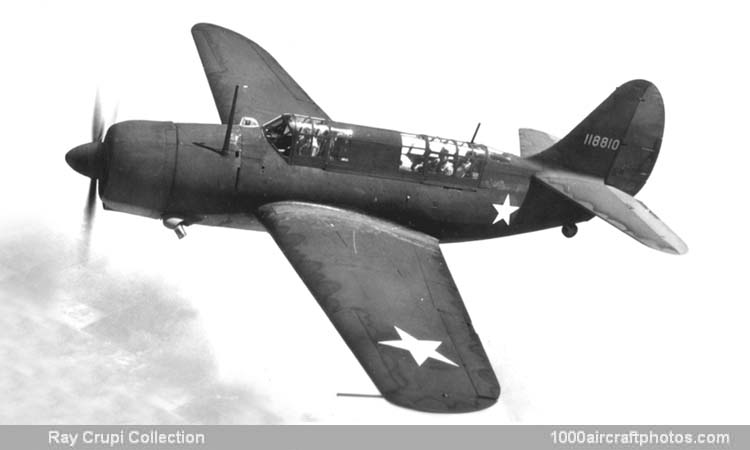09/30/2010. Remarks by Johan Visschedijk: "The last of the Curtiss SB2C-1 dive-bomber series to appear were the A-25As for the US Army. As combat airplanes they were destined to be stillborn.
Their story begins with the phenomenal success of Luftwaffe dive bombing in support of the German advances across Europe. Based on this success, the US Army became interested in dive bombing as a separate method of ground attack from the low level strafing and bombing practiced by Army Attack Squadrons. With the expansion of the Army Air Corps in 1940, procurement of dive-bombers was added to the planning and the Army turned to the Navy's SBD and SB2C to fill this mission.
In late 1940 agreement was reached for the Navy to procure approximately 100 SB2C type dive-bombers from Curtiss under the recently signed Navy contract. Referred to as SB2C-1A for procurement and designated A-25A by the Army, these were to be standardized as much as possible with Navy production. An order for 100 was added to the Navy contract on December 31, 1940. By the end of 1941 much larger quantities of A-25As were being considered and the Navy felt that all the production capacity at Curtiss-Wright's Columbus Plant was required to meet its needs.
The Army Air Materiel Command therefore directed that the St. Louis Plant of Curtiss-Wright be turned over to production of A-25As. By spring, procurement of 3,000 more A-25As had been initiated, to be built in St. Louis. From here on, the problems of coordinating engineering and manufacturing between two plants, which was not particularly eased by the fact that both were divisions of the same company, was added to the problems of coordinating Army and Navy requirements.
The A-25A became the model 84B within the Curtiss organization, and soon had its own series of drawings to account for different engineering and shop practices between the plants. The A-25A was to have larger main wheels, larger pneumatic tail wheel, Army radio and additional forward and underside armor plate. Redesign for the needed larger wheel well was done for both models to maintain standardization. Major subcontractors and suppliers for the Navy production were retained for the A-25A in order to enhance standardization.
On September 29, 1942, almost exactly three months after the initial flight of the first production SB2C-1, the first A-25A Shrike was flown. It included the folding wings and the wing slats of the SB2C-1. Production and testing proceeded more slowly than the Columbus program. By March, 1943, the final A-25A of the first block of ten had been rolled out-it was the last with folding wings. By this time action was well underway to transfer the A-25A program to an Army contract since the attempts to maintain standardization were holding up both programs.
The transition added further to delays in A-25A production due to problems with inspection authority, government furnished equipment and subcontracts. However, with production well underway, the Army reached two conclusions: (1) the A-25A was its best dive-bomber and (2) the Army had no use for dive-bombers. Thus the A-25As were delivered to various second-line activities to serve training, target towing and other needs.
By the end of 1943 the A-25As were redesignated RA-25As to denote their non-combat status. They also traded their assigned popular name, Shrike, for the Navy's Helldiver, the only item of increased standardization since the beginning of the program. Early in the A-25A program, 150 airplanes had been allocated for the RAAF to help meet their critical need for combat types. However, with the program delays and the RAAF's decision that dive-bombers were no longer needed, 140 of these were considered surplus to RAAF needs and were never delivered.
With production of RA-25As reaching a peak, and no further requirement for the type, the program took another turn. 410 airplanes, including the 140 intended for the RAAF and the last 268 off the line were to be transferred to the Navy for use as land based dive-bombers by the Marines, with the line closing down when 900 had been built. By this time many changes had been incorporated in the RA-25A design to meet Army requirements, including elimination of the wing slats and changes to the control surfaces.
Following a configuration review for the Marine Corps, a program was set up to send the transferred airplanes through modification centers operated by NAF Roosevelt Field, New York, Consolidated-Vultee, Allentown, Pennsylvania and Delta Airlines. There service changes were incorporated along with the planned modifications and the SB2C-1As were issued to Marine VMSB squadrons for operational training. Additional service changes were found necessary after delivery and these were incorporated by the squadrons.
By the end of 1944 when all SB2C-1As had been modified and delivered, transfer to the Navy's Operational Training Command and to other uses began. The Marine/Navy SB2C-1As were destined also for a non combatant role, and both Army and Marine/Navy land based Helldivers were declared surplus at an early date.
The pictured aircraft was assigned to 482 Bomber Squadron, 339 Bomber Squadron at Walterboro, South Carolina. Within a year of being built the aircraft was lost when due to an engine failure it crashed 25 mls (40 km) southwest of Walterboro, on July 11, 1943."
